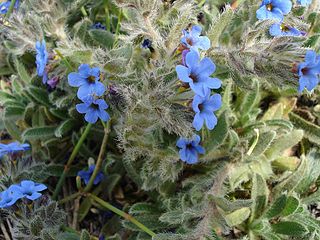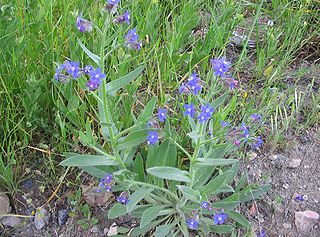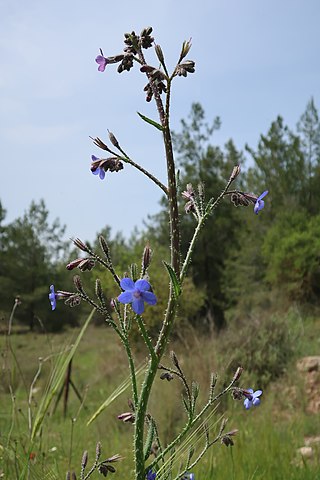
Alkanna tinctoria, the dyer's alkanet or simply alkanet, is a herbaceous flowering plant in the borage family Boraginaceae. Its roots are used to produce a red dye. The plant is also known as dyers' bugloss, orchanet, Spanish bugloss, or Languedoc bugloss. It is native to the Mediterranean region. A. tinctoria has 30 chromosomes and is regarded as a dysploid at the tetraploid level.

Boraginaceae, the borage or forget-me-notfamily, includes about 2,000 species of shrubs, trees, and herbs in 146 to 154 genera with a worldwide distribution.

The genus Anchusa belongs to the borage family (Boraginaceae). It includes about 35 species found growing in Europe, North Africa, South Africa and Western Asia. They are introduced in the United States.
Bugloss is a name used for several plants in the borage family (Boraginaceae):

Pentaglottis is a monotypic genus of flowering plants in the family Boraginaceae. It is represented by a single species, Pentaglottis sempervirens, commonly known as green alkanet or evergreen bugloss, and it is one of several related plants known as alkanet. It is a bristly, perennial plant native to southwestern Europe, in northwest Iberia and France.

Cynoglottis barrelieri, Barrelier's bugloss or false alkanet, is a species of flowering plant in the Boraginaceae family. It is a perennial native to southeastern Europe, Crimea, Turkey, Lebanon, and Syria. It is sometimes used as an ornamental plant.
Viper's grass most commonly refers to many species in the genus Scorzonera, and can be occasionally styled as viper's-grass.

Anchusa arvensis is a plant species of the genus Anchusa. Its common names include small bugloss, annual bugloss, field bugloss and alkanet.

Anchusa officinalis, also knowns as common bugloss or common alkanet, is a species of flowering plant in the borage family. It is native to Europe and small parts of western Asia, but has been escaped from cultivation to grow in additional locations in Europe and the Americas. The flowers are noted for their popularity with bumblebees due to a large nectar flow. The plants have been used in traditional medicines, but were falling out of favor by the early 1800s. They are still planted in gardens for their popularity with bees and their blue flowers.

Anchusa azurea is a species of flowering plant in the family Boraginaceae, known by the common names garden anchusa and Italian bugloss. This bristly herbaceous perennial may reach 1.5 m (4.9 ft) tall and 60 cm (24 in) wide. It has straight lance-shaped leaves and petite tubular flowers about 15 millimeters across with five bright violet-blue petals. These flowers, which typically appear in May–July, are edible and attract bees. This species is native to Europe, western Asia, and eastern Maghreb.
Arvensis, a Latin adjective meaning in the fields, is the specific epithet of the following:
A. arvensis may refer to:
A. tinctoria may refer to:
British NVC community OV17 is one of the open habitat communities in the British National Vegetation Classification system. Although classed with communities OV15 and OV16 as an arable weed community of light lime-rich soils, it also shares many features with the communities classed as arable weed and wasteland communities of fertile loams and clays.
A. officinalis may refer to:

Coleophora pennella is a moth of the family Coleophoridae. It is found in most of Europe.

Hormuzakia aggregata is a flowering annual plant in the borage family, known by the common names massed alkanet, Arabic: لسان الثور, and Hebrew: לשון-שור מגובבת.

Anchusa strigosa is a non-succulent species of herbaceous plants in the Boraginaceae family endemic to the Eastern Mediterranean regions, particularly, Greece, Turkey, Lebanon, Israel, Jordan, and Iran. It is known widely by its common names of strigose bugloss and prickly alkanet.

Anchusa capensis, is a species of flowering plant in the family Boraginaceae, native to Namibia, South Africa and Lesotho. The genus Anchusa is from the Greek word anchousa, which makes reference to its use as a dye base for cosmetic paint obtained from the roots of another plant in the genus Anchusa tinctoria. The species capensis translates to ‘from the Cape’ referring to South Africa
This page is based on this
Wikipedia article Text is available under the
CC BY-SA 4.0 license; additional terms may apply.
Images, videos and audio are available under their respective licenses.










